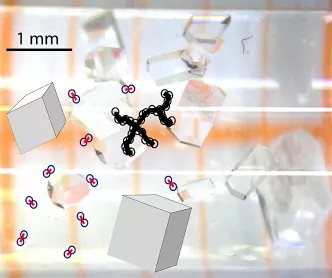Here, the problem lies in producing large crystals to achieve the desired atomic resolution. Many applications that use this method fail due to the lack of sufficiently large crystals.
The studies on the crystallization of lysozyme showed that fractals play a major role in crystal growth. Fractals are objects made up of individual lysozyme molecules, which are always arranged in the same structure even at infinite magnification. The lysozyme molecules initially form long straight chains. In a later stage of crystallization, the chains increasingly branch out and form a self-similar, three-dimensional fractal object. These objects continue to grow and then form the first crystal nuclei. Later, these objects are then entirely incorporated into the growing crystals.
Previously, scientists could only study the special role of fractals using light scattering techniques. The Jülich researchers, however, were able to support their findings by combining three different measurement techniques applied to the very same sample. They used a static light scattering device and a special in-situ dynamic light scattering set-up at the same sample cell placed in the neutron beam of the small angle neutron scattering instrument D11 at the ILL. Previously, they had tested their experimental setup at the small-angle scattering instrument KWS-2 at the Heinz Maier-Leibnitz Zentrum.
Their result is a very detailed description of the crystallization of lysozyme, making it possible to improve crystallization conditions for other proteins. This may in turn open up new ways of growing sufficiently large crystals for many other proteins for use in neutron protein crystallography and will therefore widen the scientific application of this method.
Original publication:
Crossover from a Linear to a Branched Growth Regime in the Crystallization of Lysozyme
R. J. Heigl, M. Longo, J. Stellbrink, A. Radulescu, R. Schweins, and T. E. Schrader
Crystal Growth & Design, January 23, 2018
DOI: 10.1021/acs.cgd.7b01433
